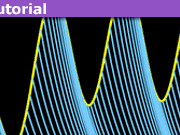Learn Further Sums Found Through Fourier Series
In an earlier insight, I looked at the Fourier series for some simple polynomials and what we could deduce from those series. There is a lot more to be found, however.
Table of Contents
Evaluating the Fourier series at π/2
First series
In the last insight, I showed that if f(x) = x for -π<x<πand f(-π)=f(π)=0, the general term of the series was [itex]a_{n}=\frac{(-1)^{n}}{in}[/itex] with [itex]a_{0}=0[/itex]. Since f(x) is differentiable at π/2, the Fourier series converges at that point, giving [tex]\frac{\pi}{2}=\sum_{n=-\infty}^{-1}\frac{(-1)^{n}}{in}e^{in\frac{\pi}{2}}+0+\sum_{n=1}^{\infty}\frac{(-1)^{n}}{in}e^{in\frac{\pi}{2}}[/tex]
Changing n to –n in the first sum, we get[tex]\frac{\pi}{2}=\sum_{n=1}^{\infty}\frac{(-1)^{n}}{-in}e^{-in\frac{\pi}{2}}+\sum_{n=1}^{\infty}\frac{(-1)^{n}}{in}e^{in\frac{\pi}{2}}[/tex]
Now [itex]\frac{e^{inx}-e^{-inx}}{2i}=\sin(nx) [/itex] and therefore [itex] \frac{\pi}{2}=2\sum_{n=1}^{\infty}\frac{(-1)^{n}}{n}\sin(\frac{n\pi}{2})[/itex]. Since [itex]\sin(\frac{n\pi}{2})[/itex] is 0 for all even multiples of p/2 and alternating between +1 and -1 for odd multiples, we have [tex]\frac{\pi}{4}=\sum_{n=1}^{\infty}\frac{(-1)^{n-1}}{2n-1} [/tex]
Not exactly a new result, it is usually known as Leibniz’ formula, but it shows that our calculations are correct.
A bit more unusual: The result can also be written as [itex]\frac{\pi}{2}=\sum_{n=1}^{\infty}\frac{(-1)^{n-1}}{n-\frac{1}{2}}[/itex]. Compare this result with the well-known fact that [itex]\sum_{n=1}^{\infty}\frac{(-1)^{n-1}}{n}=\ln(2)[/itex]…
Second series
In the last insight, I used f(x) = x2 for -π≤x≤π. The general term was then [itex]a_{n}=\frac{2}{n^{2}}[/itex] with [itex]a_{0}=\frac{\pi^{2}}{3}[/itex]. Inserting x=π/2 gives [tex]\frac{\pi^{2}}{4}=\sum_{n=-\infty}^{-1}\frac{2}{n^{2}}e^{in\frac{\pi}{2}}+\frac{\pi^{2}}{3}+\sum_{n=1}^{\infty}\frac{2}{n^{2}}e^{in\frac{\pi}{2}}[/tex]
Change n to –n in the first sum and reorder: [tex]\frac{\pi^{2}}{4}-\frac{\pi^{2}}{3}=\sum_{n=1}^{\infty}\frac{2}{n^{2}}e^{-in\frac{\pi}{2}}+\sum_{n=1}^{\infty}\frac{2}{n^{2}}e^{in\frac{\pi}{2}} [/tex]
Now [itex]\frac{e^{inx}+e^{-inx}}{2}=\cos(nx)[/itex] and therefore [tex] \frac{-\pi^{2}}{12}=4\sum_{n=1}^{\infty}\frac{1}{n^{2}}\cos(\frac{n\pi}{2})[/tex].
Since [itex]\cos(\frac{n\pi}{2})[/itex] is 0 for all odd multiples of π/2 and alternating between +1 and -1 for even multiples, we have [tex]\frac{-\pi^{2}}{48}=4\sum_{n=1}^{\infty}\frac{(-1)^{n}}{n^{2}} [/tex]
Change sign and reorder: [tex]\sum_{n=1}^{\infty}\frac{(-1)^{n-1}}{n^{2}}=\frac{\pi^{2}}{12} [/tex]
Again, a known fact, but it verifies our procedure.
Staying with the inverse squares, let us try a slightly more unusual function.
Let f(x) be periodic with period 2π where f(x) = cosh(x) for -π≤x≤π. Then [tex]a_{n}=\frac{1}{2\pi}\int_{-\pi}^{\pi}\cosh(t)e^{-int}dt=\frac{1}{2\pi}\int_{-\pi}^{\pi}\frac{1}{2}(e^{t}+e^{-t})e^{-int}dt[/tex][tex]=\frac{1}{4\pi}\int_{-\pi}^{\pi}(e^{t-int}+e^{-t-int})dt[/tex][tex]=\frac{1}{4\pi}(\frac{1}{1-in}(e^{\pi-in\pi}-e^{-\pi+in\pi})-\frac{1}{1-in}(e^{-\pi-in\pi}-e^{\pi+in\pi})) [/tex]
Remembering that [itex]e^{-in\pi}=e^{in\pi}=(-1)^{n}[/itex], we have [tex]a_{n}=\frac{1}{4\pi}(\frac{1+in}{1+n^{2}}(-1)^{n}(e^{\pi}-e^{-\pi})-\frac{1-in}{1+n^{2}}(-1)^{n}(e^{-\pi}-e^{\pi})[/tex][tex] =\frac{(-1)^{n}}{2\pi}(\frac{1+in}{1+n^{2}}(-1)^{n}\sinh(\pi)+\frac{1-in}{1+n^{2}}(-1)^{n}\sinh(\pi))[/tex][tex]=\frac{(-1)^{n}}{\pi}(\frac{\sinh(\pi)}{1+n^{2}}) [/tex]
For n=0 we have [tex]a_{0}=\frac{1}{2\pi}\int_{-\pi}^{\pi}\cosh(t)dt=\frac{1}{2\pi}(\sinh(\pi)-\sinh(-\pi))=\frac{\sinh(\pi)}{\pi} [/tex]
Thus [tex]\cosh(x)=\sum_{n=-\infty}^{-1}\frac{(-1)^{n}}{\pi}\frac{\sinh(\pi)}{1+n^{2}}e^{inx}+\frac{\sinh(\pi)}{\pi}+\sum_{n=1}^{\infty}\frac{(-1)^{n}}{\pi}\frac{\sinh(\pi)}{1+n^{2}}e^{inx}[/tex][tex] =\frac{\sinh(\pi)}{\pi}(1+\sum_{n=1}^{\infty}\frac{(-1)^{n}}{1+n^{2}}(e^{inx}+e^{-inx}))[/tex]
For this tells us (the convergence of the series is trivial) that[tex] \cosh(\pi)=\frac{\sinh(\pi)}{\pi}(1+\sum_{n=1}^{\infty}\frac{2}{1+n^{2}}[/tex]
Reordering this expression, we get [tex] \sum_{n=1}^{\infty}\frac{1}{n^{2}+1}=\frac{1}{2}(\pi\coth(\pi)-1)[/tex]
If we evaluate the series for [itex]x=0[/itex] instead, we get [tex]\cosh(0)=1=\frac{\sinh(\pi)}{\pi}(1+\sum_{n=1}^{\infty}\frac{2\cdot (-1)^{n}}{1+n^{2}}[/tex]
Reordering this expression, we get [tex]\sum_{n=1}^{\infty}\frac{(-1)^{n}}{1+n^{2}}=\frac{1}{2}(\frac{\pi}{\sinh(\pi)}-1) [/tex]
Adding 1 to both sides of the expression, we get[tex]\sum_{n=0}^{\infty}\frac{(-1)^{n}}{n^{2}+1}=\frac{1}{2}(\frac{\pi}{\sinh(\pi)}+1) [/tex]
Third series
In the last insight, I used f(x) = x3-π2x. Here I will just change the sign and use [itex]f(x)=\pi^{2}x-x^{3}[/itex]. It will, of course, change the sign of the calculated coefficients, so [itex]a_{n}=\frac{-6}{in^{3}}[/itex] with [itex] a_{0}=0[/itex]. Inserting x=π/2 gives [tex] \frac{\pi^{3}}{2}-\frac{\pi^{3}}{8}=\sum_{n=-\infty}^{-1}\frac{-6}{in^{3}}e^{in\frac{\pi}{2}}+\sum_{n=1}^{\infty}\frac{-6}{in^{3}}e^{in\frac{\pi}{2}}[/tex]
Reordering: [tex]\frac{\pi^{3}}{16}=\sum_{n=1}^{\infty}\frac{1}{in^{3}}e^{-in\frac{\pi}{2}}+\sum_{n=1}^{\infty}\frac{-1}{in^{3}}e^{in\frac{\pi}{2}} [/tex]
Again, we have a sine function, so [tex] \frac{\pi^{3}}{32}=\sum_{n=1}^{\infty}\frac{(-1)^{n-1}}{(2n-1)^{3}}[/tex]
Reducing the denominator: [tex] \sum_{n=1}^{\infty}\frac{(-1)^{n-1}}{(n-\frac{1}{2})^{3}}=\frac{\pi^{3}}{4}[/tex]
These results may be new, I do not know (I certainly have not seen them before).
Read my next article: Why Road Capacity Is Almost Independent of the Speed Limit
Master’s in Mathematics, Norway. Interested in Network-based time synchronisation.






Did you notice that Mathematica disagrees on the sign of the last one?No, saw it just now. Mathematica is correct, the correct exponent for (-1) should be (n-1), not n.
Then Mathematica and I agree. Fine!
For me this is part of the road I am currently going. As long as I am getting correct answers along the way, I am happy.Did you notice that Mathematica disagrees on the sign of the last one?
Mathematica gave this:Then Mathematica and I agree. Fine!
For me this is part of the road I am currently going. As long as I am getting correct answers along the way, I am happy.
Mathematica gave this:
View attachment 213068
Quick Latex pointer: if you write "left(" and "right)" instead of "(" and ")" you get parentheses which self-adjust their height.